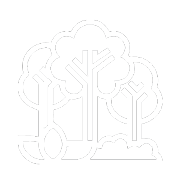REDD+
Reducing Emissions from Deforestation and Degradation
These are projects that generate carbon credits from the 40-year conservation of an existing native forest. There are two types of REDD+ project:
- The APD follows the Avoided Planned Deforestation methodology and basically consists of avoiding the deforestation of areas legally authorized for the suppression of vegetation; in this case, the Legal Reserve surplus.
- The AUD follows the Avoided Unplanned Deforestation methodology, i.e. avoiding illegal deforestation of preservation areas, such as Legal Reserve areas, Permanent Preservation Areas (PPA) and Conservation Units (CU).

REDD+
A barrier to deforestation
After recording a 36% reduction in primary forest loss in 2023 compared to 2022, Brazil has once again returned to the spotlight in global deforestation statistics — and this time in an even more alarming way. In 2024, the country saw a dramatic 147.3% increase in tropical primary forest loss, totaling 2.82 million hectares — an area nearly 25 times the size of the city of Rio de Janeiro. The data comes from the Global Forest Watch (GFW) platform, managed by the World Resources Institute (WRI).
This alarming surge was driven by one of the most severe fire seasons ever recorded, which devastated an area 6.6 times larger than in 2023 and accounted for 66% of all forest loss in the country. Meanwhile, losses not related to fire increased by 13%, mainly due to deforestation for soybean cultivation and the expansion of cattle ranching. According to Brazil’s Prodes/INPE satellite monitoring system, nearly 20% of the Amazon biome has already been deforested, totaling around 75 million hectares. Furthermore, the study The drivers and impacts of Amazon forest degradation, published in the journal Science, reveals that approximately 38% of the remaining forest is experiencing some level of degradation.
This scenario brings the rainforest dangerously close to its tipping point — the ecological threshold beyond which it can no longer recover, triggering a process of savannization of the humid tropical forest. Among the consequences are changes in South America's rainfall patterns and the emergence of new desertification zones in Brazil.
In this context, REDD+ projects have become an essential tool for halting illegal deforestation and also for reducing legal deforestation in areas that exceed the Legal Reserve. In addition to protecting threatened forest areas, these projects actively work to prevent and combat wildfires, deter land invasions, and curb illegal practices, such as unsustainable logging. As WRI emphasizes, long-term financial mechanisms and policies that value standing forests are crucial to making them less vulnerable to economic pressures — and to ensuring their protection can endure beyond political cycles and electoral shifts.
46% of Brazil's annual emissions come from land-use and forest changes
(SEEG 2024)
Avoided Emissions
5+ million
tCO2e avoided by 2023*
*Vintages verified by Verra
Area under conservation
350+
thousand hectares*
*REDD+ projects in progress and under validation
Projects
Financial incentives for conserving tropical forests in private areas
Amazonas

REDD+ APD (Avoid Planned Deforestation)
Protecting forests and earning fair payments, helping to reduce carbon emissions
Acre

REDD+ AUD (Avoid Unplanned Deforestation)
Contributing to the preservation of the Amazon, generating financial compensation and conserving forests
Amazonas

REDD+ APD (Avoid Planned Deforestation)
Fighting deforestation, protecting forests and promoting sustainable practices
Pará

REDD+ AUD (Avoid Unplanned Deforestation)
Working to reduce deforestation and degradation in the Amazon and attract investments
Legal Amazon

REDD+ APD (Avoid Planned Deforestation)
Over 15 years' experience in carbon projects
Check out what some landowners have been saying
“I recommend brCarbon to other producers. With the price of beef today, one of the best solutions is to produce in a sustainable way, while preserving the forest, and I'm not afraid to recommend brCarbon to anyone because I believe it will be a great solution for us, cattle ranchers.”

“I am a supporter of both the company and the way it is conducting the process: serious, transparent, involvement of the surrounding community, independent evaluations and audits. We're pleased with it and the projections and calculations are very attracting. Today it is more profitable to keep the forest preserved than to raise cattle in the same area.”
